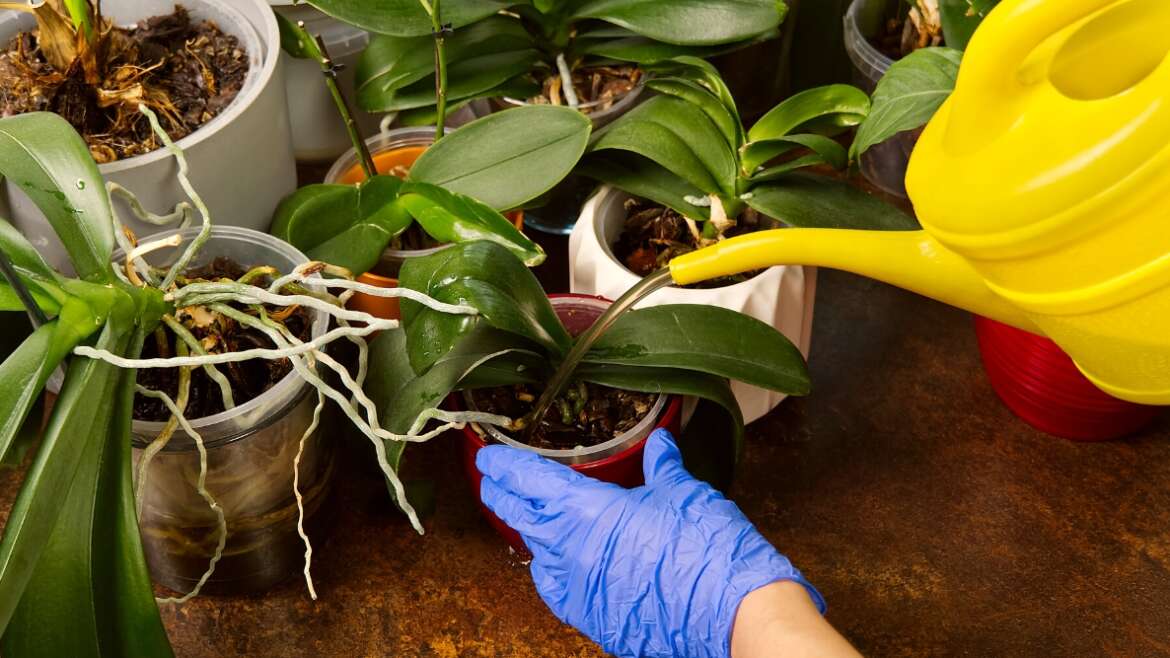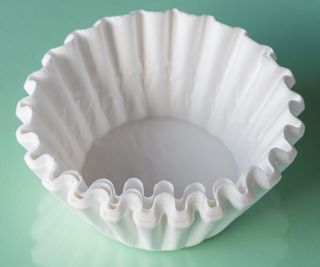Orchids are a well-loved and highly sought-after group of plants that make great houseplants if you provide them with the right conditions. In the proper environment, orchids are low-maintenance and require little from their owners aside from watering and fertilizing.
Sadly, when things go wrong with orchids, their health tends to deteriorate rapidly, leaving you with sad-looking leaves that could be black, brown, or yellow rather than the rich green of a healthy plant.
If you’ve noticed discoloration on your orchid’s leaves, the time to act is now. Leaf damage is not commonly reversible and will only continue to spread and cause more damage as time goes on. I’ve compiled a list of potential causes for leaf discoloration and some advice on taking care of the situation going forward.
Over or Underwatering
Orchids possess delicate roots that are sensitive to excessive moisture.
Orchids have sensitive watering needs. All orchids, particularly epiphytic orchids, have delicate roots that don’t like to stay wet all the time. If your roots stay wet for too long, you can end up with fungal issues, which can cause the leaves to turn yellow with brown at the edges.
Underwatering can also cause leaves to become dry and brown. If your orchid’s leaves are turning brown and shriveled, they are likely dehydrated. Overwatered leaves will still have a plump appearance.
Orchids are tropical plants that like a lot of moisture, but their roots will not tolerate sitting in a wet potting mix for any long periods. It’s important to establish a good watering schedule where your plant gets the moisture it needs but doesn’t stay wet all the time.
Most indoor orchids, if they are potted in a container and with a potting mix that is very well draining, should be watered about once per week. In times of active growth and flowering, they may need a bit more water, and when they are dormant, they need less.
Water Quality
 Rainwater is ideal for orchids, though collecting it can be cumbersome.
Rainwater is ideal for orchids, though collecting it can be cumbersome.
If you are watering your orchids with tap water, chemicals like chlorine can cause damage to the leaves. Well water may also contain additional harsh minerals or additives that may impact your orchid’s roots.
The best water for orchids is rainwater, but that can be a bit of a chore in terms of collecting it. Distilled water is a great substitute if you think that chemicals in the water could be responsible for turning your orchid leaves brown.
Lack of Humidity
 Orchids, like Vandas, suffer in home conditions with insufficient humidity, resulting in browning leaves.
Orchids, like Vandas, suffer in home conditions with insufficient humidity, resulting in browning leaves.
Orchids need a fair amount of humidity to stay healthy. These plants require between 40%-80% ambient humidity, depending on the species, to perform their best. For orchids that need humidity levels on the higher end, the conditions inside the home are not optimal for their health.
Some types of orchids are better suited to greenhouse conditions than what we can create comfortably in the home. Vandas, for example, need about 80% humidity to grow their best. With a lack of humidity, the leaves can turn brown, particularly around the edges.
There are a few things you can do to increase the humidity around your orchid. I house my orchids in a bathroom window, as the steam from the shower makes the bathroom the most humid in the house. But don’t worry if you don’t have a window in the bathroom or one that gets enough light.
A humidifier is a great way to elevate the humidity in the immediate vicinity of the plant. If you prefer to keep the moisture contained, a pebble tray is a good way to create more moisture in the air around your orchid. This will work well for orchids that only need a moderately high level of humidity.
Cold Damage
 Severely damaged leaves are prone to rot, leading to more significant problems.
Severely damaged leaves are prone to rot, leading to more significant problems.
Orchids are not cold-weather friendly. They do best when they are kept at a steady temperature between 65-85°F. For indoor orchids, this is fairly simple, as there will rarely be a temperature shift of more than 10° at any time. However, orchids that live outdoors all or most of the year can be damaged by cold temperatures.
If you live in a cooler climate and keep your orchids outdoors during the warmer months, keeping a close eye on the weather is important. Orchids should be brought indoors when temperatures are getting down toward 50°F. Indoors, orchids should be kept away from drafts or doorways.
There is no quick fix for the leaves in this case. If the damage is mild, you can simply leave them intact. Just keep an eye on them in case the damage spreads or begins to turn black. If the leaves are very damaged, they are likely to rot, and that will cause bigger issues.
Remove the damaged foliage if the damage seems to be expanding. Keep your plant cozy indoors until the temperature outside is consistently over 50°F.
Fertilizer Burn
 Water the roots just before fertilizing to safeguard them and help absorb the nutrients.
Water the roots just before fertilizing to safeguard them and help absorb the nutrients.
Too much of a good thing isn’t always a good thing. Orchids like to be fertilized and typically do well with a bi-monthly fertilizer schedule. The type and concentration of the fertilizer, as well as its application, are all factors in the plant’s health.
If you are using a too strong or concentrated fertilizer or are applying fertilizer to dry roots, you could see some browning on your orchid’s leaves caused by fertilizer burn on the roots.
Always water your orchids immediately before fertilizing. This will help to protect them while also allowing them to absorb the nutrients in the fertilizer. Less is more in terms of concentration. As long as you are fertilizing regularly, you can use a diluted formula. A 10-10-10 formula, for example, should be diluted to half strength for orchids.
Sunscald
 Swift action is crucial if you spot sun damage on your orchid’s leaves.
Swift action is crucial if you spot sun damage on your orchid’s leaves.
Some orchids can tolerate direct sun exposure, but most prefer that their light be either indirect or diffused. Direct sun can cause sunscalding on your orchid’s leaves.
I can recall leaving a phalaenopsis outdoors in the sun, waiting to be re-potted. There were large pale splotches on the leaves in just a few short hours.
Most importantly, if you notice sun damage on your orchid’s leaves, move it to a shadier spot or find a way to diffuse the light. A sheer curtain or privacy film both work well for this purpose.
If your orchid has sunscald, the burned places are likely to turn brown or black as the tissue decays. Decaying tissue is a fast route to crown rot if you allow the entire leaf to rot on the plant. Remove any leaves that show signs of rotting as soon as you notice it.
Fungal or Bacterial Disease
 Small brown or black spots on orchid leaves often indicate these diseases.
Small brown or black spots on orchid leaves often indicate these diseases.
Because of their humidity needs, orchids are prone to issues with fungal and bacterial diseases. Many of these pathogens are waterborne and can splash from one plant to another due to poor watering hygiene.
Often, this is the culprit when you notice smaller brown and black spots on the leaves. Some of these diseases are easily manageable, and others can cause quite a headache, particularly if the damage is not mitigated quickly.
Take care when watering your orchids. Watering from the top down will usually result in some water splashing on the leaves. Watering your orchids from underneath really is the best way to avoid introducing waterborne pathogens onto the leaves of your plants. Always isolate a plant when you notice leaves looking like they’ve been affected by disease.
To treat the issue, remove the affected foliage. It won’t do any harm to treat your plant with a copper-based fungicide to ward off any further infection should a small amount be left on the plant somewhere.
Pests
 Maintaining plant health is the best defense, enhancing resilience and stress tolerance.
Maintaining plant health is the best defense, enhancing resilience and stress tolerance.
Quite a few insects like to feed on the sweet sap of orchid plants. Aphids, mealybugs, scales, and spider mites are all insects that are attracted to orchids. These pests will drain nutrients, leaving leaves looking unhealthy.
Insects also leave a sticky, sweet excrement behind them, which makes a hospitable environment for black sooty mold to grow. The mold interferes with photosynthesis, and it’s all downhill from there. You can end up with a very sickly-looking plant.
Keep an eye on your orchids and inspect them for pests each time you water them. The best defense is a good offense, meaning that the healthier your plant is, the more resilient it will be and the more stress it can handle.
If you discover that your orchid is a bug buffet, isolate it away from other plants because those little guys spread quickly. Wash the foliage gently but thoroughly, knocking off as many of the offending pests as possible. Then treat the foliage with neem oil or insecticidal soap. You may need to treat again in a couple of weeks to make sure you get any newly hatched insects.
Natural Causes
 Orchids naturally shed their oldest leaves annually, often before or after blooming.
Orchids naturally shed their oldest leaves annually, often before or after blooming.
If you notice the oldest leaf or pair of leaves on your orchid turning brown and taking on a withered appearance, and the rest of the plant is healthy and robust, it is probably time for those leaves to die.
Orchids shed their oldest leaves about once per year. This occurrence commonly happens just before or directly after the plant blooms. As the plant prepares to bloom, many nutrients and energy are spent on the flowers, so the oldest leaves tend to suffer.
You can allow nature to run its course and let the plant decide when it is done with those older leaves. They will eventually fall off on their own, and it shouldn’t cause any harm to the plant in the process. If you don’t like how these dying leaves look, cutting them off also causes no harm.
The exception is when a sympodial orchid looks like it is losing its oldest pseudobulb. Spent pseudobulbs should be left on the plant until they are dry and brown. They contain nutrient stores that the plant can use to create healthy new growth, so it’s good to allow the plant to get as much from them as possible.
Final Thoughts
Whatever the cause of your orchid’s leaf discoloration, acting quickly is important to the overall health and recovery of the plant. By monitoring your orchid and inspecting when you water it weekly, you can get ahead of any major issues and maintain a healthy and beautiful plant.




